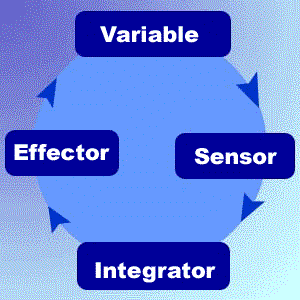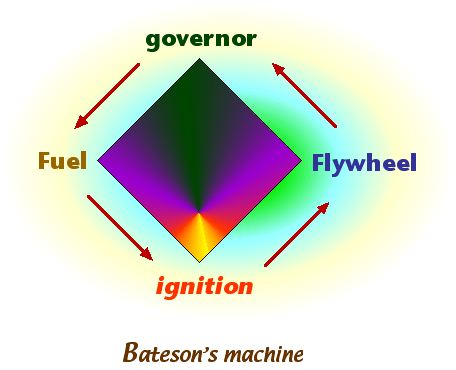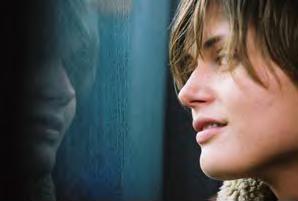 Horace Freeland Judson
Horace Freeland Judson“Scientists are building explanatory structures, telling stories which are scrupulously tested to see if they are stories about real life."
Dr. Ernst Mayr explaining biological ideas about macroevolution and the origin of species.
Plan of the book:
Knowing & Power
Next
A mirage poses a problem for our senses.
Eight Problems
“Knowledge is Power” Emerging from an arrogant ignorance of life.
- "Because of new information, we change the ways in which we view the world."
- "We are not so much the center of things any more, because of science."
- "We feel lost, or at least not yet found." So we have not yet found our place.
- We are not as informed about our role in the universe as we thought we were a few centuries ago. . . ."
- existence were led to believe had meaning, but "We have learned that we do not really understand nature at all, and the more information we receive, the more strange and mystifying is the picture before us."
Lewis Thomas, pp.xv-xvi.
What is the definition of a problem?
The difference between an existing and a desired state of affairs.
Can a problem be an issue, or a puzzle, or a conundrum, or an obstacle, or a recipe?
For example consider observations and the impact of "observer effects."
Linguistically the word problem [is derivative of a Greek word problema (problema) meaning to put forth] means a difficult question, a matter of inquiry, or an enigma, hence something hidden.
Introduction by Lewis Thomas, MD
"The transformation of human society by science is probably only at its beginning and nobody can guess how it will turn out.""The technology that derives from science." technology as applied science
"much of today's public argument over whether science is good or bad is really an argument about the value of technology, not about science."
Horace Freeland Judson: is a science writer.
"Scientific knowledge is the most reliable knowledge we've got."
"unities of approaches that bring us such reliable knowledge."
"the content of science is inseparable from processes of discovery & testing."
Chapter One: Investigation and the Rage to Know.
Circular method of problem solving
- Read the problem
- Pick the main points
- Select an outcome
- Test your assumptions
- Correct previous errors
- Make an educated guess
Chapter Two is titled: "Pattern"
This chapter starts off with the author telling a story about his trip to London, England. Judson talks about how the patterns and lifestyles of the people in England are very different from ours. He then gives examples: such as Americans not having tea at four-thirty everyday, or not being familiar with the different direct current (DC) of electricity, or not being used to the automobiles of London, which are smaller with a higher pitch sounding engine.
Essentially Judson is saying that one doesn't really notice the everyday patterns of our lives until we experience a foreign country.
He then goes into great detail about specific patterns and how they have been incorporated into our lives.
One interesting statement he presented was that there is more diversity in a square mile of a rain forest than in all of the areas of Mars, Jupiter, and the Moon combined.
A pattern is formed by drilling a hole into a solid granite rock and filling it with water, allow the water to freeze, the cracks in the ice will create three sections each intersecting each other at 120 degrees.
This same pattern of 120? degrees can be found in dried mud as well as in honey combs and molecules.
Cholera
One way that patterns are used is in the curing of disease. An example of this is in the case of a disease called cholera which was discovered in England. Hundreds of people died all in the same area . This disease had occurred in random, isolated cases, but nothing of this magnitude. John Snow came to the conclusion that this disease was as a result of contaminated sewage in the water supply. John later isolated this water to one source, which was a public water well right in the middle of the area of deaths. Snow eventually proved to the people and the pump handle was removed. However, the actual organism that caused this disease was not identified until forty years later.
pp. 38-39.
Blue are the water sources, the size of the red circles indicates the number of cholera incidents.
". . . the water being from the Broad Street pump." John Snow's 1854, cholera map restored.
The interesting part to this disease is that it appears again in 1978. Isolated cases were being reported around the world and especially in Europe! A researcher, Charles Ronald, came up with an interesting hypothesis by studying the patterns of where the disease was occurring in relation to the flight paths of airplanes. Airplanes then used to discharge all wastes into the air. This was done to the fact that the waste would be frozen in droplets and thawed out several times while falling. So the airline industry believed that no organism could live after such changes in temperature. However, Ronald proved them wrong by making tests of these reactions.
As a result of Ronald’s findings the airline industry changed their policy on waste disposal.
Now all wastes are collected into a storage tank, while most sinks drain directly into the atmosphere. The only other problem of our modern planes is that the wastes from the toilet do drain into our atmosphere if there is an overflow!
pp. 39-40.
Chapter 3 is next.
Chapter Three is Change:
Sizes: area & volume ratio involves the scale effect;
linear > doubles
area > squared
volume > cubed
Chapter Four is Chance

Perhaps nothing else so sets off the daily habits of mind of scientists from other people's as does the willingness to accept the inevitability of uncertainty in some crucial matters, and the consequent necessity to act on the basis of good probabilities. Many psychiatrists smoke, but I know few biologists who do so."
(page 84)
Charles Darwin said that the variations from which all life has descended, originated in chance, or random mutations.
Survival of the fortunate.
Chapter 5 is next.
Chapter Five is about Feedback
What is Feedback?
a contingent process involving reinforcement on an initial condition with either of two responses:


Positive Negative
+ -
continues impedes
reinforces the initial stimuli counters the initial stimuli
examples are
Nerves, hormones, neurotransmitters, DNA & RNA, hormones, amino acids
Feedback is a sequential process in which the factors that produce a result are themselves modified, corrected or strengthened by that result (product).
It occurs in information processing, electrical circuits, nerve impulses, hormonal cycles, population.
Feedback is a model of science itself.
( page, 126. )
Pathology of positive feedback versus therapeutics of negative feedback
Electrical information: the transfer of part of the output of an active circuit or device back to the input in order to affect the future input.
"Biologists soon observed that entire ecological systems are self-regulatory by feedback."
Noise > = < Fidelity } interference
Noise is that feedback which interferes with a transmitted signal.Background disturbances must be isolated for one to distinguish the frequency of the message from the scatter of the interfering frequencies.
Chapter 6 is next.
Chapter Six is about Modeling:
Modeling reveals a two part paradox about how scientists and technologists think.
The first part of the paradox is that model-making is a profound and instinctual human response to comprehending the world.
The second part is modeling, no matter how serious, enshrines an element of play.
In science and engineering, the model leaves out the trivial details to embody the important, the useful, the crucial features of the thing modeled - the features that make a difference.

Bateson’s model is based on four related sequences
Bateson's "machine" is a model. Parts are steps in a process: 1 2 3 4 concepts originate instigate operate regulate His model of those ideas fuel ignition flywheel governor Translating those ideas source oxidation gravity feedback Examples of these precepts: sunlight photosynthesis rain CO2 CO2 is carbon dioxide that is also related to pH, for which to measure, we use a Litmus test.
§§§
Try modeling the tree of life's ancestral relations, shown below in four probable varieties.
However, Philip Anderson, a Nobel Prize winning Physicist, warned,
“Model-building entails hazards for the builder and the reader. The builder may leave out something genuinely relevant, the reader, armed with. . . too accurate a computation, may take literally a schematized model whose main aim is to be a demonstration of possibility.”
The advantages of modeling an object’s performance are obvious: models are a means to trial and error -- a way to make mistakes safely and relatively cheaply. An example of this is how the test ship for the America’s Cup Competition is a one-eighth scaled modeled that could cost $80,000 while the actual boat will cost over a million.
Where the model of an object attempts to predict performance, the model of a complex system tries to predict outcomes.The two most complex systems for which models are now being built are the weather and the economy. It’s simple to accumulate and map vast amounts of data about either system- statistics from weather stations or of interest rates, consumer optimism, machine-tool purchases, and so on. Data can be charted hourly for the weather or quarterly for the economy. To see how the rates of change are themselves changing, and how these changes interact so that the performance of the entire system slows, stops, turns in the other direction, is extremely difficult. However, something very simple would be of virtually no use.
Very complex models have been made possible through the use of computers. With computers, economic models can chew up incredible masses of data, by multiple, repeated comparisons of trends they establish which the data merely reflect more fundamental changes. The models the allow the predictions to be compared with what actually ensues- in order to correct and redefine the model.
Chapter Seven is Strong Predictions:
Prediction is, . . . the most characteristic and pervasive element in animal behavior and in human speech and thought: it is the dynamo of the feedback process.
Planets, Alpha Helix, Haley, Einstein
"the English expedition has really proved the deflection of light from the sun."
Albert Einstein
Michelson & Morely experiment
was on the influence of direction on the speed of light
Fitzgerald’ interpretation of the experiment: the “ether” shrinks in response
Lorenz Transformation
Minkowski's math
Henri Poincare’s relativity principle
1905 Special Relativity
constant velocity
acceleration & mass
1911 introduced the "general" terminology
1915 General Relativity
1916 a full explication of the Theory of General Relativity
includes acceleration & gravitation as the warp & woof of space
Mercury's perturbations: The perihelion of Mercury was off by 43 seconds of arc / century! precedents of Uranus & Neptune"General relativity forced such a wrenching readjustment of patterns of thought that for years it met hostility, even from many scientists." (165)
The bending of star-light by the gravitational disturbance of space bound by time -- a tensor-like continuum of time, space, matter and energy.
"a ray of light going past the sun undergoes a deflection of 1.7 seconds of arc."
A. Einstein
GENERAL THEORY OF RELATIVITY, (1916)Einstein was a Swiss Patent Office Clerk; Swiss neutrality in the Great War.
May 29, 1919, the eclipse of the sun in the South Atlantic allowed Arthur Edington to photograph five stars and measure the displacement as the eclipse progressed.
sixteen exposures of from 2-20 seconds. The measurement & correction of the photographs yielded 1.61 seconds of arc displacement! .9° of an arc from the theoretical prediction.
Sir Edmund Haley predicted the reappearance of the (1682) comet "Haley" in the 1758 to the very night and quarter of the sky in which the comet actually appeared."
His prediction was done on the basis of observation & sustained by formulas [acting as a model] derived from the Laws of inverse squares and other proofs of Newtonian mechanics based on the PRINCIPIA MATHEMATICA'S proofs and the elliptical laws of motion by Kepler.
Kepler took Tycho Brahe's diligent observations of the Martian orbit and concluded that the pattern was similar to those inscribed in conic sections.
![]()
The ellipse is the equation that satisfies the predictive rigor required (necessary & sufficient causes) of theories by observations and discoverable mathematical principles.
Deductive method of Geometry &
Inductive method of planetary observations
Intuitive leap from Platonic forms and perfect circles to the ellipse.
Three Laws of Planetary Motion, by Johannes Kepler; 1609.
Max Perutz
1915 Nobel Prize winner for the development of X-RAY Crystallography
1912 common salt is described by the shape of sodium chloride atomic bonds
All amino acids and the hydrogen bonds that link them into a chain of proteins -- THE BOND LINKING TWO AMINO ACIDS MUST BE FLAT -- according to Linus Pauling!
MAY 1951, Pauling & Corey at CAL TECH published the descriptive measurement of the ALPHA HELIX
Paulings' model made a strong prediction. It told Perutz precisely where to look to find a phenomenon that had never been seen or expected !"
Chapter Eight is Evidence.
What is Evidence?
"These cases illustrate the fact that the emotional balance of the victim or eyewitness is so disturbed by his extraordinary experience that his powers of perception become distorted and his identification is frequently most untrustworthy"
Dr. E. M. Borchard, 1932.mistaken identity by eyewitnesses to violent crime proven "unreliability of eyewitness identification evidence poses one of the most serious problems in the administration of justice."
Dr. Elizabeth Loftus
Gervase of Canterbury, 1178 AD, recorded in a chronicle the cratering impact on the moon as an eyewitness to the probable creation of the Crater. Giordano Bruno on the Moon.
Nucleic Acid researchThe confirmation occurred 8 centuries later by two pieces of evidence:
- ] size and visibility
- ] lunar - laser instrumentation
Galileo named the Jovian moons; he contrasted
Copernican theory vs. Ptolemaic theory.
heliocentric geocentric
The superior relation of theory to empirical observation
artifacts are those aspects of an experiment that occur because of the way the experiment is set up and are not generated by the things [phenomenon] you hope to discover.
"OBSERVER EFFECTS"
"Even more than in law, in science the evidence of the observer is subject to powerful and distorting pressures. "
Rare is "A . . . [study] . . . free of the suspicion of the unconscious bias in observing. . . . "
pp. 208-209.
1668-72 Newton's experimentation with visible spectra of sun light.
"Isaac Newton experimented with prisms and lenses in the years 1668-1672, and based an entire theory of the nature of color and an of light on the solar spectrum. He did not report the . . .
"He did not report the absorption lines."
"In 1961, William Bisson at M.I.T. built an apparatus like Newton's, reconstructed the original experiments, and showed that the absorption lines would have been plainly visible. Bisson and his colleague reported this in a note in Science in 1962, concluding, " 'We saw the lines' and wonder why Sir Isaac Newton failed to. . . ."
"the absorption lines would have been plainly visible."p. 209.
"The question provoked Edwin Boring to argue, . . . that Newton's theory, not his apparatus, had no place for the lines; theoretical expectations blinded him to the evidence."
pp. 209-210.
"To the observing scientist, hypothesis is both friend and enemy."
p. 210.
Examples of expectation errors:
Census under-count about 2%
Red corpuscle samples mistakenly tallied in accordance with the counter's expectations
p. 211.
Allegedly scientific, these were errors nonetheless:
"N-Rays," 1903: disproved only 2 years later.
"placebo effect" in drug and toxin testing requires the necessity of control studies
Piltdown Man 12/19/1912 anomalous evidence, disproved in 1953!
Inheritability of IQ or Intelligence quotient test scores.
"Too close to ideal distributions to seem real." [219]
There is no evidence that IQ is inheritable; thus it remains an acquired trait.In Scientific research fraud is severely dealt with, "the sanctions are severe. . . because detection is so difficult." (220)
"Even more than in law, in science the evidence of the observer is subject to powerful and subtle distorting pressures."
1) When clarifying any problem the initial step is to establish the facts.
2) Then determine the boundaries or framework of the problem given what is known about the issues raised.
3) Next contrast what you know with what you need to discover in order to solve the problem.
What we know
"The frontiers of science – most of the time in most sciences – are at east as likely to be set by limitations of technique as by limitations of the imagination"
"Again and again, a new device or a new level of observation has set scientists' imaginations free, or given theory the jolt and the discipline of the unexpected."
p. 221.
"Reality is not an exhibit for man's inspection, labeled 'Do not touch.' There are no appearances to be photographed, no experiences to be copied, in which we do not take part. We remake nature by the act of discovery, in the poem or in the theorem” (1956)
ideal representation vs. actual things

Imagined Experienced
Fantasy Reality
on off
go stop
long short

The above is a dialectical approach to understanding an established pattern of relations among many things.
Theory is Chapter Nine:
"In the dialogue between the possible and the actual, the search for solutions, what qualities of mind are required?"
p. 227.
the possible & the actual
"You just have to try and imagine what – the universe – is like."
Paul DIrac, quoted on p. 244.
"I'd say that the ability to discover analogies, the ability to generalize, the ability to strip to the essential attributes of some actor in the process -- these are some pretty obvious talents."
"I think that the ability to move from one level of analogical reasoning to another, and not get stuck in the analogy at inappropriate times, is terribly important."
"You have to be able to fantasize in rather crude ways -- but then be able to shift from one frame of reference to another. That, I think is more rare than you might suppose."
Joshua Lederberg, quoted on p. 228.
"Scientific reasoning is a kind of dialogue between the possible and the actual between what might be and what is in fact the case."
"interactions between hypotheses and the logical expectations they give rise to."
(p. 126)
There appeared to be a feedback between fact and idea --- between model & evidence.
observation and theory require that we have both fact & framework.
Horace Freeland Judson, The Search for Solutions. Baltimore: Johns Hopkins University Press, 1987.
Meaning & Francis Bacon's four idols
Einstein's discoveries.
Aristotle | Bachelard | Bateson | Bronowski | Capra | Carson | Darwin | Dawkins | Ehrlich | Einstein | Feynman | Gell-Mann | Halley | Hansen | Hardin | Hawking | Judson | Kaku | Keller | Lewontin | Margulis | Newton | Occam | Schmidt | Steingraber | Tattersall | Thomas
Note: John Snow produced a famous map in 1854 showing the deaths caused by a cholera outbreak in Soho, London, and the locations of water pumps in the area. By doing this he found there was a significant clustering of the deaths around a certain pump – and removing the handle of the pump stopped the outbreak.